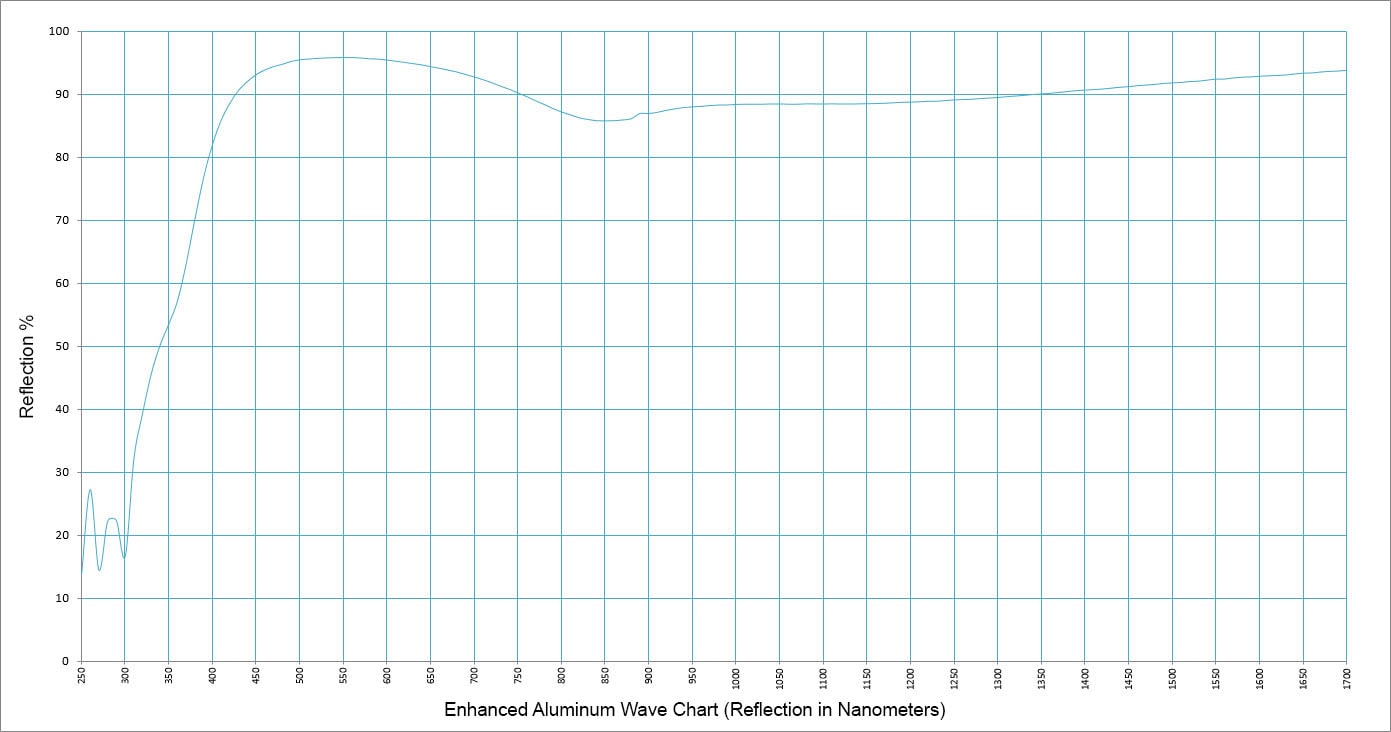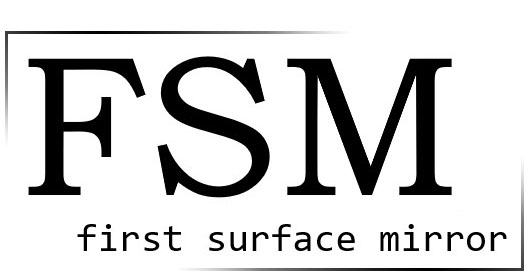Product: Glass front surface mirror
Substrate: Float glass, clear. Microcorrugation ≤ 20 µm/20 mm.
Selective double flat (1/4″ thickness only, sizes 32″x50″ and less): 1 wave per inch
Dimensions: Sizes and glass thicknesses available on request. A cutting tolerance of ± 1.5mm applies to all final dimensions.
Angularity: Angular deviations allowed within dimensional tolerance.
Edge Finish: Coated side has unfinished edges. Caution: unfinished edges are sharp. Handle with care. Uncoated side has seamed edges:
- Maximum 5 chips allowed per edge
- Maximum chip length: 5mm
- Chips may extend into glass surface for maximum 30% of the glass thickness
- Edge fractures are not allowed
Edges chamfered as per drawing specifications.
Coating: Single-side coating: Aluminum with an interference coating for reflectivity enhancement, deposited by magnetron sputtering under a high vacuum.
Spectrophotometric curve measured at normal incidence

No less than 94% reflectivity for the visible region as measured with a Weston photronic cell with a Viscor filter and illuminated by a tungsten lamp supplying light at an angle of incidence of 22.5°.
Adherence: No mirror coating will be removed by the cellulose tape test described here. The adhesive side of cellulose tape is carefully placed in contact with a portion of the mirror surface and firmly rubbed against it. It is then quickly removed with an action that exerts the highest possible stripping action.
Corrosion Resistance: The mirror has no noticeable deterioration of the finished mirror when given a salt atmosphere in a thermostatically controlled cabinet for 24 hours at 95° Fahrenheit (35° Celsius). The salt atmosphere is created by allowing a stream of bubbles through a salt solution containing 1.5lbs (0.68 kg) per cubic ft of water.
Effect of Temperature: The coating is not effected by ambient temperature of -60° Fahrenheit (-51° Celsius)to 500° Fahrenheit (260° Celsius).
Hardness: Film is not removed when the following test is applied: Clean dry cheese cloth bearing the force of 1 lb (566 grams) is rubbed against the coating 200 times.
Durability Requirements:
- Abrasion test, 200 strokes, 1lb (566 grams), with cheesecloth
- Adhesion test with 3M 8981 Scotch tape
- Humidity test, 48 hours, 95% relative humidity, 50° Celsius
- Immersion test in salt solution, 37g/l, 24 hours at room temperature
- Salt spray test to ISO 9227 NSS, 48 hours
- Wipe test (20 cycles) with isopropyl alcohol, glass cleaner, acetone
- Immersion test in isopropyl alcohol, acetone, 2h at room temperature
- Cycling test (4 hours at 80° Celsius, 4 hours at -30° Celsius, 16 hours at homidity to ISO 6270 Part 1), 4 cycles
- High-temperature storage (7 days at 100° Celsius)
Following these tests, the coating does not show any defects such as stains, delaminations, or pinholes The required minimum reflectance values are still exceeded after the tests.
Defect Standards: For all semi-finished products, a rim area of 5mm all around is excluded from the inspection
| Deflect Type | Defect Size | Number Allowed | Min Defect Distance |
| Pinholes & glass defects |
> 0.7 mm | Not allowed | |
| > 0.2 to < 0.7 mm | Unlimited | 50mm | |
| < 0.2 mm | Not evaluated but no clouding |
||
| Scratches | Width up to 0.08 mm | Total length, Max 1/3 of longest edge |
50mm |
| Width up to 0.01 mm | Not evaluated |
Staining: Stains in the coating that are visible in reflected light at a light intensity of 1500 Lux are not allowed.
Visual Inspection in reflection:
- The visual inspection in reflection is performed on a test location with a light intensity of 1500 Lux.
- For the inspection, the mirrors are positioned in front of a black background. The incidence angle of the light source on the front surface mirror is approximately 30° to the vertical.
- The coated side of the front surface mirror is toward the observer.
- Before the visual inspection is performed, the complete surface of the glass is wiped with an alcohol-soaked cloth.
- The visual inspection for surface defects (scratches, stains) and impurities is performed at a distance of approximately 70 cm.
Visual Inspection in transmission:
- The visual inspection in reflection is performed in a light box with 1500 Lux.
- The glass panel is placed in the light box so that the front surface mirror is positioned vertically with the coated side toward the observer.
- The front surface mirror is inspected for coating defects (scratches, pinholes) from a distance of approximately 50 cm.
